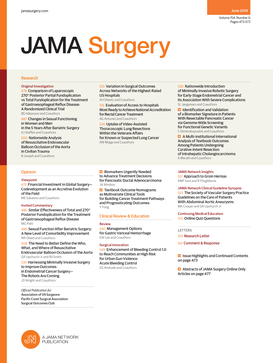基因组衍生的胰腺腺癌分类器和切除术后预后
IF 15.7
1区 医学
Q1 SURGERY
引用次数: 0
摘要
重要性瘤腺癌(AA)具有临床和基因组异质性。与标准组织学分类相比,以前开发的基因组分类器能更准确地定义不同的生物表型。这项回顾性队列研究在 6 家国际学术机构进行。研究对象包括接受组织学确诊 AA 治疗性切除术的连续患者(n = 192)。暴露将之前在3411例患者(1001例胰腺腺癌、165例远端胆管腺癌和2245例结直肠腺癌)的前瞻性测序队列中训练的多层次元特征回归模型应用于AA测序数据,以量化亲源细胞的相对比例。结果在192例AA患者中(中位年龄69.0 [IQR,60.0-74.0]岁,男性134例[64%]),免疫组织学亚型与基因组亚型的一致性为55%。大多数 INT 亚型肿瘤被归入结直肠基因组亚型(57 例中有 43 例 [72.9%])。在 114 个 PB 亚型肿瘤中,29 个具有胰腺基因组特征(25.4%),24 个具有远端胆管基因组特征(21.1%)。虽然标准免疫组织学亚型与生存率无关(对数秩 P = .26),但预测的基因组概率与生存概率相关。结直肠概率较高的基因组评分与较高的生存概率相关;胰腺和远端胆管概率较高的基因组评分与较低的生存概率相关。这些数据提供了一种可纳入临床试验进行前瞻性验证的分子分类方法。本文章由计算机程序翻译,如有差异,请以英文原文为准。
Genome-Derived Ampullary Adenocarcinoma Classifier and Postresection Prognostication
ImportanceAmpullary adenocarcinoma (AA) is characterized by clinical and genomic heterogeneity. A previously developed genomic classifier defined biologically distinct phenotypes with greater accuracy than standard histologic classification. External validation is needed before routine clinical use.ObjectiveTo test external validity of the prognostic value of the hidden genome classifier of AA.Design, Setting, and ParticipantsThis retrospective cohort study took place at 6 international academic institutions. Consecutive patients (n = 192) who underwent curative-intent resection of histologically confirmed AA were included. The data were analyzed from January 2005 through July 2020.ExposuresThe multilevel meta-feature regression model previously trained on a prospectively sequenced cohort of 3411 patients (1001 pancreatic adenocarcinoma, 165 distal bile duct adenocarcinoma, and 2245 colorectal adenocarcinoma) was applied to AA sequencing data to quantify the relative proportions of parental cell of origin.Main Outcome and MeasuresGenomic classification was correlated with immunohistologic subtype (intestinal [INT] or pancreatobiliary [PB]) and with overall survival (OS), using the log-rank test and Cox proportional hazard models.ResultsAmong 192 patients with AA (median age, 69.0 [IQR, 60.0-74.0] years and 134 were male [64%]), concordance between immunohistologic and genomic subtypes was 55%. Most INT subtype tumors were categorized into the colorectal genomic subtype (43 of 57 [72.9%]). Of the 114 PB subtype tumors, 29 had a pancreatic genomic profile (25.4%) and 24 had a distal bile duct genomic profile (21.1%). Whereas the standard immunohistologic subtypes were not associated with survival (log rank P = .26), predicted genomic probabilities were correlated with survival probability. Genomic scores with higher colorectal probability were associated with higher survival probability; higher pancreatic and distal bile duct probabilities were associated with lower survival probability.Conclusions and RelevanceThe AA genomic classifier is reproducible with available molecular testing in a diverse international cohort of patients and improves stratification of the divergent clinical outcomes beyond standard immunohistologic classification. These data provide a molecular classification that may be incorporated into clinical trials for prospective validation.
求助全文
通过发布文献求助,成功后即可免费获取论文全文。
去求助
来源期刊

JAMA surgery
SURGERY-
CiteScore
20.80
自引率
3.60%
发文量
400
期刊介绍:
JAMA Surgery, an international peer-reviewed journal established in 1920, is the official publication of the Association of VA Surgeons, the Pacific Coast Surgical Association, and the Surgical Outcomes Club.It is a proud member of the JAMA Network, a consortium of peer-reviewed general medical and specialty publications.
 求助内容:
求助内容: 应助结果提醒方式:
应助结果提醒方式:


